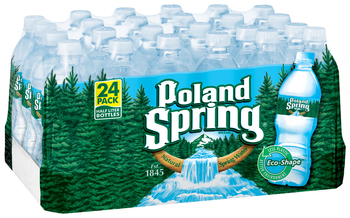Friday, January 7, 2011
Best and worst bottled water brands
By Lori Bongiorno
How much do you know about the bottled water you drink? Not nearly enough, according to a new report released today from Environmental Working Group (EWG). “Bottled water companies try hard to hide information you might find troubling,” says Jane Houlihan, senior vice president of research for the Washington D.C.-based research and advocacy group.
[Read more: Cities with the best (and worst) tap water]
EWG analyzed the labels of 173 unique bottled water products and company websites to determine if companies disclose information on where water comes from, how or if their water is treated, and whether the results of purity testing are revealed. The nonprofit also looked at how effective (and advanced) any water treatment methods are. Researchers followed up by calling dozens of bottled water companies to find out which ones willingly tell consumers what’s in their bottles.
The Environmental Protection Agency says on its website that consumers have the right to know where their water comes from and what’s in it so they can “make informed choices that affect the health of themselves and their families.” Tap water is regularly tested and consumers can find their local water info online. That’s not necessarily the case with bottled water, which is not required to disclose that information to consumers. “Bottled water is a food product and every one of these companies is complying with federal law,” says Tom Lauria, of the International Bottled Water Association.
[Video: The story of bottled water]
More than half of the bottled water products surveyed failed EWG’s transparency test –18 percent didn’t say where their water comes from, and another 32 percent did not disclose any information on treatment or purity of water.
Only three brands earned the highest possible marks for disclosing information and using the most advanced treatment methods available -Gerber Pure Purified Water, Nestle Pure Life Purified Water, andPenta Ultra-Purified Water.
On the other end of the spectrum, these six brands got the worst marks in EWG’s report because they don’t provide consumers with the three basic facts about water on product labels or their company website – Whole Foods Italian Still Mineral Water, Vintage Natural Spring Water, Sahara Premium Drinking Water, O Water Sport Electrolyte Enhanced Purified Drinking Water, Market Basket Natural Spring Water, and Cumby’s Spring Water.
How does your bottled water brand stack up? Here’s a look at the 10 top-selling* U.S. brands:
1. Pure Life Purified Water (Nestle), EWG grade = B
2. Arrowhead Mountain Spring Water (Nestle), EWG grade = C
3. Aquafina Purified Drinking Water (Pepsi), EWG grade = D
4. Dasani Purified Water (Coca-Cola), EWG grade = D
5. Deer Park Natural Spring Water (Nestle), EWG grade = D
6. Ice Mountain Natural Spring Water (Nestle), EWG grade = D
7. Ozarka Natural Spring Water (Nestle), EWG grade = D
8. Poland Spring Natural Spring Water (Nestle), EWG grade = D
9. Zephyrhills Natural Spring Water (Nestle), EWG grade = D
10. Crystal Geyser Natural Alpine Spring Water (CG Roxane), EWG grade = F
Filtered tap water received the best grade (an A) from EWG because if you change your filter regularly, EWG says it is purer than bottled water, plus it saves money (bottled water can cost up to 1,900 times more than what flows from your tap). Drinking tap water also takes less of a toll on the planet. EWG offers plenty of tips for filtering your tap water so that you can drink the healthiest water possible.
[Related: Giving up bottled water saves a shocking amount of money]
What should you do when bottled water is your only option? “While our top choice is filtered tap water, when you do need to choose bottled water, we recommend brands that tell you what’s in the water and that use advanced treatment technologies like reverse osmosis and micro-filtration,” says Houlihan. Advanced treatment technologies remove pollutants that other methods don’t. You should look for bottled water products that tell you where the water is coming from and how pure it is.
Here are the results for all 173 bottled water brands included in the report. You’ll find that some less popular brands rank even lower than our list of top-sellers.
The advice to drink filtered tap water can seem confusing when there are often reports about the contaminants found in municipal water supplies. Just last month, for example, EWG announced that cancer causing hexavalent chromium (chromium-6) is in 31 cities’ tap water. Houlihan says chromium-6 is as likely to be in your bottled water as it is in your tap water and we need action from the federal government on this. She points out that a reverse osmosis filter can remove the worrisome contaminant. You can guarantee its removal in your home supply, but in many cases you don’t know what’s in the bottle you’re drinking from.

